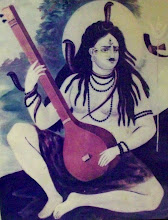VOCAL
The sarangi players who got converted to very successful vocalists are
U. abdul karim khan of kirana gharana
U. Badegulamali khan of patiala gharana who accompanied Inayatibai deronwali in his early career.
U. Amirkhan of Indore gharana, he was a son of sarangiya shahmir khan
surprisingly abdulkarimK & amirK never liked sarangi as an accompaniment to their vocal performance, instead they preferred harmonium,while badegulamaliK hardly preferred harmonium, he always enjoyed sarangi as an accompaniment to his vocal.
DIFFERENT INSTRUMENT
Now let us know the people who switched to other instrument from sarangi playing.
One was Patiala gharana musician U. Abdul Aziz khan, who played beautiful sarangi with female singer Chhamiya. On getting humiliated by getting too less reward, he broke sarangi & picked up veena, took out all the frets & created new instrument vichitra veena or Batta bin. It was played with big oblong glass or stone (called batta) sliding over the strings. He earned much respect as binkaar too.After partition on India, he shifted to pakistan. His younger brother U. Habibali earned good name as binkar
Another person was U. Ahmed raza, a disciple of U. abdul aziz khan who also took to batta bin. His sarangi can be heard in older tracks with U. ahmedjan thirakwa. He has one or two albums of batta bin to his credit.
Third person though occasionally but definitely played saraswati veena, i.e. U. abdul karim khan (KIrana gharana vocal stalwart). His veena tracks were published commercially too. He was into sarangi playing in his early career.
This is to my knowledge & I will be happy if somebody can add to this list.
Another person was U. Ahmed raza, a disciple of U. abdul aziz khan who also took to batta bin. His sarangi can be heard in older tracks with U. ahmedjan thirakwa. He has one or two albums of batta bin to his credit.
Third person though occasionally but definitely played saraswati veena, i.e. U. abdul karim khan (KIrana gharana vocal stalwart). His veena tracks were published commercially too. He was into sarangi playing in his early career.
This is to my knowledge & I will be happy if somebody can add to this list.
